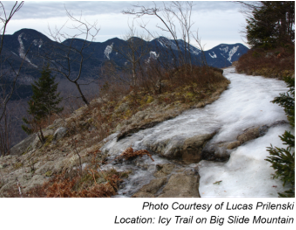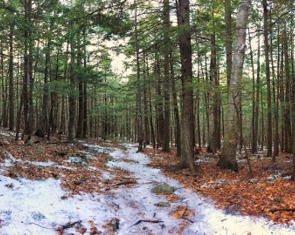|
Have a safe and enjoyable outdoor recreational experience on the lands and waters of the Adirondacks. Properly plan and prepare for your outdoor adventure. Minimize the impact on the mountains and forests, rivers and brooks, ponds and lakes, and the wildlife of the Adirondacks.
Backcountry Information for the Adirondacks web pages provide information on access, outdoor recreation infrastructure, and current conditions for those planning to recreate in the Adirondacks.
Would you like your photo shared in our weekly bulletin? Send us your photos that represent current backcountry conditions in the Adirondacks. Send in your photos with your name and photo location/brief description to Info.R5@dec.ny.gov or simply tag #NYSDEC on Instagram.
PLAN
Weather forecasts and conditions can and do change quickly. Check the current National Weather Service Forecast and be prepared for the forecasted conditions or change your plans.
-
Plan for unexpected trail conditions. Plan to encounter all conditions on the trails. Conditions can vary from bare and hardened to wet and muddy, slushy, icy,
 or snow covered based on elevation, exposure, and location within the park. Wear waterproof boots, pack or carry snowshoes and crampons. or snow covered based on elevation, exposure, and location within the park. Wear waterproof boots, pack or carry snowshoes and crampons.
-
The use of crampons is advised. Due to the continuing warm weather, trails are still very icy, especially at high elevations. Micro spikes are suitable on level ground but not on trails on slopes. Crampons are recommended. Bring snowshoes in case deep snow is encountered.
-
Expect high water levels and swift currents on rivers and streams. Melting snow and rain raise water levels. High fast-moving waters make stream crossings on trails dangerous and even impossible. Heed high water warnings and find a safer alternate route or trip. Do not try to cross through cold, high, fast flowing waters.
PREPARE
Properly prepare to better ensure a safe and enjoyable winter recreation experience.
- Mud: Temperatures, amount of rainfall, location, and altitude effect the start of mud season. While spring may not be officially here yet, snow and ice have mostly melted in lower elevations, and warmer temperatures can create muddy trails. If mud is encountered;
- Wear waterproof footwear and gaiters
- Walk through - not around - mud and water on trails to avoid trampling vegetation and widening of trails. This can cause unnecessary and irreversible damage and increase erosion
- Layering for spring-like temperatures: Temperatures at the trail head will vary from temperatures at your destination. Higher elevations and exposed summits can have significantly colder temperatures than the base of the mountain. Pack extra non-cotton, wind protectant layers and be sure to use them once exposed or feeling colder to help prevent hypothermia.
- Stream crossings may be impassable. Prepare to take alternate routes or turn back if a stream crossing is impassable. Recent thaws, icy conditions, and very cold water, fast moving streams should be avoided. Keep dogs on leashes near fast moving water.
PRACTICE LEAVE NO TRACE
 Follow proper trail etiquette to maintain minimal impact on the environment and the natural resources of the Adirondacks as well as ensuring an enjoyable outdoor experience for all visitors by following the Seven Principles of Leave No Trace. Follow proper trail etiquette to maintain minimal impact on the environment and the natural resources of the Adirondacks as well as ensuring an enjoyable outdoor experience for all visitors by following the Seven Principles of Leave No Trace.
- Travel and Camp on Durable Surfaces (Principle #2): Primitive Camping
- Durable surfaces include established trails and campsites, rock, gravel, dry grasses or snow. If taking advantage of the warmer temperatures by camping; camp at existing campsites where a “camp here” disc is found, keep campsites small by focusing activity in areas where vegetation is absent, and camp at least 200ft from lakes and streams (maybe further depending on high waters). Avoid creating larger camp sites and degrading vegetation due to mud. Plan to find an alternate campsite. Campfires are prohibited in the High Peaks Wilderness.
- Dispose of Waste Properly (Principle #3)
- Pack it in, pack it out. Pack out everything you brought in with you. Trash and litter should not be buried in the snow. Be sure and pick up all food scraps and other litter. Bring along an extra trash bag to pack out litter left behind by others. Solid human waste should be packed out. If packing human waste out is not an option, dig a cathole 6-8 inches deep at least 200 feet away from travel routes and water sources. Cover and disguise cathole when finished. If you use toilet paper, be sure to use it sparingly and pack it out.
- Plan Ahead and Prepare (Principle #1): Emergency Situations
- If you get lost or injured; keep calm and stay put. If you have cell service, call the DEC Forest Ranger Emergency Dispatch (518-408-5850). Try to stay warm and dry by separating yourself from the wet snow with a thicker layer on the ground. Protect yourself from the elements by building a shelter with items around you and in your pack. Build a campfire to provide heat, light and comfort. A campfire will also be useful for search crews to locate you.
GENERAL CONDITIONS/NOTICES
Learn the conditions you will encounter from Adirondack Backcountry Information.
-
Late Winter Conditions: Continued above freezing daytime temperatures have resulted in a significant loss of snow pack. Snow depths range from 0 to 10 inches. The deeper snows depths can be found in the center of the Adirondacks and the High Peaks Region. A snowstorm forecast for Friday through Saturday is expected to bring up to a foot of snow across the southern and central Adirondacks and in the High Peaks Region, and up to 6 inches across the northern Adirondacks but only 1 to 4 inches in the eastern Adirondacks. See the NERFC Snow Page for current snow information. Learn how to have a safe and enjoyable outdoor winter experience.
-
Snowmobile Trails: Many gates and snowmobile trail systems have closed due to the lack of snow. However, snowmobile trails may be reopened this weekend, particularly across the southern Adirondacks, if forecasted snow amounts do occur. Check local conditions before going out.

-
Trail Conditions: Low elevation trails will have bare ground, thin snows, icy surfaces, water, mud or a mixture of all. Trail crampons and other traction devices should be carried for use on lower elevation, less steep trails. Deeper, soft snows in the higher elevations will require the use of snowshoes. Snowshoes may be required in other locations Saturday depending on the how much snow accumulation occurs.
-
Ice on Trails: Thick ice is present on high elevation trails especially on bedrock summits, steep rocky slopes, and other exposed areas. The thick ice will be covered by snow after the storm passes. Carry mountaineering or climbing crampons if you plan to encounter these conditions and use when warranted – trail crampons are ineffective.
-
River and Streams: Although water levels are receding, rivers and streams are running high and fast due to recent rains and warm temperatures. Ice over moving water is gone or has thinned considerably. Newly formed ice is extremely thin and may be perched above the current water level of streams. Use extreme caution at all stream crossings.
-
Ice on Lakes and Ponds: Ice is thinning on lakes and ponds especially over river channels and other moving water. DEC has received and responded to numerous reports of motorized vehicles falling through ice. Water and slush are present on the surface of the ice under the snow and above the main surface of ice. Be safe on ice.
- Always check the thickness of ice before traveling across it.
- Avoid and stay well away from ice:
- Over running water
- Near inlets & outlet
- Near boathouses & docks - especially those with "bubblers" or other ice prevention devices
-
Mountain Summit Conditions will be more extreme than those found at the trailhead. Temperatures will be colder, winds will be stronger, ice will be present, and snow will be present and deep. Check the National Weather Service Mountain Point Forecasts for selected summits.
SPECIFIC NOTICES
Notices below reflect recent changes in conditions and recreation infrastructure work completed by DEC and its partners.
-
High Peaks Wilderness:
- Lake Colden Caretaker reports 30 inches (75 cm) of snow at the stake on the shores of Lake Colden (Elevation 2,750 ft./838 m) with up to 5 to 6 feet snow (120 to 180 cm) in the higher elevations.
- Trail conditions for skiing continue to deteriorate.
- Snowshoes or skis are required wherever snow depths exceed 8 inches, essentially above 2,800 feet (855 m) elevation.
- Lake Colden and Avalanche Lake have water on the surface of the ice. Inlets and outlets continue to open and should be avoided.
- Corey’s Road in the Western High Peaks is closed beyond. It will remain closed through mud season. The road will reopen when it has dried and hardened, and all routine maintenance and repairs have been completed
-
Ausable Marsh Wildlife Management Area: The road under the train trestle has been closed due to flooding.
- Conifer-Emporium Easement Tract: Due to logging operations on the CL West Tract, DEC has closed the Cranberry Lake 50 connector trail and Lost Pond Trail to public use until further notice. The Cranberry Lake 50 trail has been temporarily re-routed to its former route State Route 3 during the closure.
- Snowmobile Trails: Numerous snowmobile trails and trail systems across the Adirondacks closed this week due to lack of snow. The trails may reopen if enough snow accumulates:
- St. Lawrence County Snowmobile Trail System
- Saratoga County Snowmobile Trail System
- South Warren County Snowmobile Trail System
- Half of the North Warren County Snowmobile Trail System
- Town of Webb Snowmobile Trail System, Herkimer County
- The Inlet gate and two miles of trail at the western end of the Moose River Plains Main Trail.
- Town of Indian Lake Snowmobile Trail System, Hamilton County
- Snowmobile trails in the towns of Caroga Lake, Bleecker, and Mayfield, Fulton County
HIGHLIGHTED TRAIL- Hammond Pond Wild Forest, North Hudson, NY
There is a small parking area off Ensign Pond Road (County Route 4) that is the trailhead for Hammond Pond, Bass Lake, Berrymill Flow and Moose Mountain Pond in the Hammond Pond Wild Forest. All four trails are great for hiking, snowshoeing, and cross-country skiing. Moose Mountain pond has a lean-to which may be accessed from the Berry Mill Flow Trailhead via the Berry Mill Flow Trail and the Moose Mountain Pond Trail. Moose Mountain Pond and Bass Lake are stocked with brook trout for fishing as well.
-
Hammond Pond Trail follows an old road. It's an easy 0.9 hike one way to a beautiful view of the pond near the old wooden dam of Black Brook. Easy hike with a minimal elevation gain and can be enjoyed by all members of your family.
-
Berrymill Flow Trail extends 1.4 miles and steadily ascends 145 feet from the trailhead to Berrymill Flow.
-
Moose Mountain Pond Trail extends 2.1 miles and ascends 245 feet from the end of the Berrymill Flow Trail to the north shore of Moose Mountain Pond and a lean-to. The trail follows old logging roads along a river with beaver activity and passes by a waterfall.
-
Bass Lake Trail extends 3.2 miles from the trailhead to the intersection of Berrymill Flow Trail and Moose Mountain Pond Trail passing along the southern shore of Bass Lake. The trail ascends 420 feet in the first 0.6 mile and then undulates over the next 2.1 miles before descending 170 feet in the last 0.5 mile
Trailhead: Located along Ensign Pond Road (County Route 4) off US Route 9.
Directions: I-87 to Exit 29, then US 9 North 2.4 miles to County Route 4 turning right. In 0.2 miles turn right onto Ensign Pond Road (still County Route 4). In 2.7 miles there will be a small parking area on the right a DEC sign.
Trailhead Coordinates: (43.9916°N, 73.6610°W)
|


 or snow covered based on elevation, exposure, and location within the park. Wear waterproof boots, pack or carry snowshoes and crampons.
or snow covered based on elevation, exposure, and location within the park. Wear waterproof boots, pack or carry snowshoes and crampons. Follow proper trail etiquette to maintain minimal impact on the environment and the natural resources of the Adirondacks as well as ensuring an enjoyable outdoor experience for all visitors by following the
Follow proper trail etiquette to maintain minimal impact on the environment and the natural resources of the Adirondacks as well as ensuring an enjoyable outdoor experience for all visitors by following the 